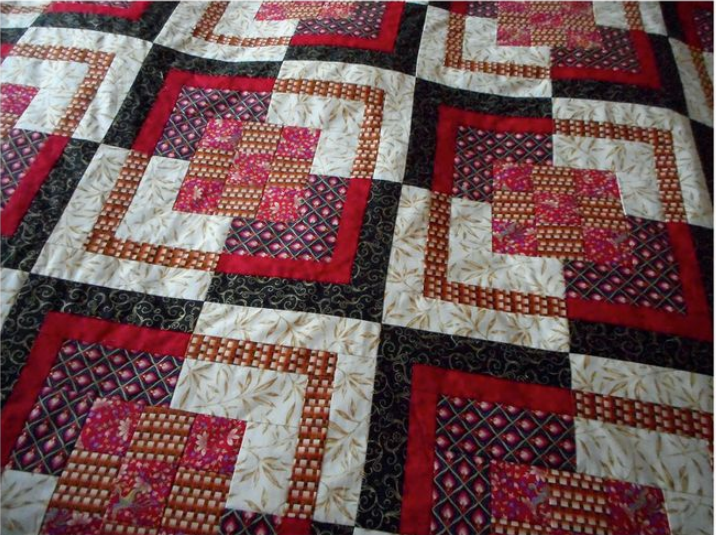When I first started quilting, I was always drawn to designs that combined simplicity with bold, structured layouts. The Nine Patch Bento Box quilt pattern fits that ideal perfectly, bringing the elegance of traditional patchwork together with a modern flair.
This quilt pattern is named after Japanese “Bento Boxes,” which are beautifully arranged and compartmentalized lunch boxes. Much like those boxes, this quilt pattern has a layered, organized look that’s satisfying to piece together.
In this project, we’ll be making blocks with a nine-patch center and building out from it in layers. If you’re new to quilting, the Nine Patch Bento Box quilt is an ideal place to start. This pattern teaches valuable techniques such as accurate cutting, quarter-inch seams, and precise pressing, skills you’ll use in almost every quilting project.
Bringing It All Together: The Structure and Beauty of the Nine Patch Bento Box
The Nine Patch Bento Box quilt is crafted from a series of carefully layered blocks. Each block starts with a nine-patch center, which is then framed by layers of coordinating strips, creating a beautiful, boxed-in effect. This quilt is a wonderful opportunity to play with color contrasts and fabric combinations, as you’ll see how different values work together to create visual depth.
Essential Color Contrast: Choosing the Right Fabrics
To make your Nine Patch Bento Box quilt truly pop, fabric selection is key. Since this quilt thrives on contrast, you’ll need fabrics with a mix of dark, medium, and light tones, as well as a “pop” color. Below are the fabric requirements based on this pattern:

Full Pattern: Click Here
Materials
- Fabric 1: Dark fabric (example: black print) – 1 ¾ yards
- Fabric 2: Lighter fabric (example: yellow paisley) – 1 yard
- Fabric 3: Medium fabric, darker than Fabric 2 (example: grayish print) – 1 ⅛ yards
- Fabric 4: Warm, contrasting color (example: reddish batik) – 1 ¼ yards
- Fabric 5: Light neutral fabric (example: ivory paisley print) – 2 ¼ yards
Getting Started: Preparation and Tips
Before diving into the piecing, make sure to have your fabrics labeled and well-organized. This quilt requires precision, so take time to cut and press each piece carefully. I also recommend laying out your fabrics on a design wall as you work to visualize how your blocks will look when they come together.
Step-by-Step Instructions
Step 1: Making the Nine Patch Centers
- Cut Strips: From Fabric 1 and Fabric 4, cut 2.5″ strips as specified. Sew two Fabric 4 strips along each side of a Fabric 1 strip to create a strip set that’s 6.5″ wide.
- Press and Cut: Press the seams toward the inner Fabric 1 strip. Square up one end, then cut twenty 2.5″ segments.
- Assemble the Nine Patch Blocks: Arrange one “A” segment (Fabric 1) and two “B” segments (Fabric 4) to form a nine-patch. Sew the rows together, pressing as you go, until you complete 20 nine-patch centers.
Step 2: Building Out with C and D Strips
- Prepare the C Strip Sets: Sew a 3.5″ strip of Fabric 3 and Fabric 5 together. Press the seam towards Fabric 3.
- Attach to Nine Patch Centers: Place C segments vertically along each side of the nine patch block, alternating the placement of Fabric 3. Sew, press, and repeat for each block.
- Add D Segments Horizontally: Use Fabric 3 and Fabric 5 in a 5.5″ strip set. Sew these above and below each nine patch block to create a boxed frame. Each block should now measure 10.5″ square.
Step 3: Adding the Final Layers with E and F Segments
- Create E Strips: Sew Fabric 2 and Fabric 4 in 5.5″ segments, pressing toward Fabric 4. Attach these along the sides of each block, creating a layered effect.
- Finishing with F Segments: For the last layer, use 6.5″ wide strips of Fabric 2 and Fabric 4. Attach horizontally to the top and bottom of each block to complete the Nine Patch Bento Box design.
Step 4: Assembling the Quilt Top
Arrange your blocks in a layout of five rows with four blocks each. You can choose to add borders or additional sashing if desired, or even split your blocks to create smaller quilts. Take your time arranging the blocks until you’re satisfied with the overall look.
Additional Tips
- Cutting Accuracy: Use a rotary cutter and ruler to ensure your strips are uniform, and square up after each strip set.
- Pressing for Precision: Each seam should be pressed carefully to avoid distorting your blocks.
- Experiment with Color: Try laying out different combinations of blocks to see how your chosen fabrics work together.
Creating the Nine Patch Bento Box quilt offers the joy of seeing structure emerge from simplicity, as each block becomes a small masterpiece within the whole. Completing this quilt will give you confidence in piecing techniques and an appreciation for the impact of color contrast.
When you lay down the final stitch and step back, you’ll see how all those carefully chosen fabrics and seams blend together to create something beautiful, a quilt that’s both modern and timeless.
